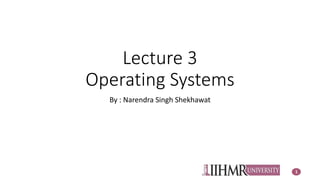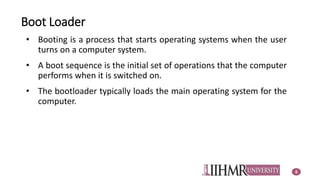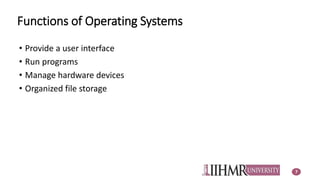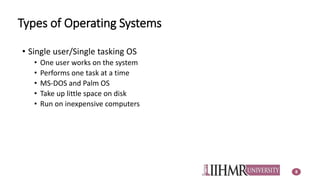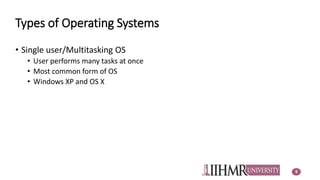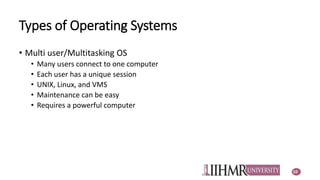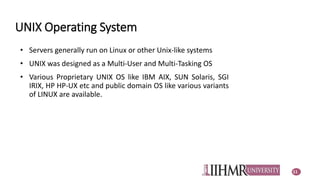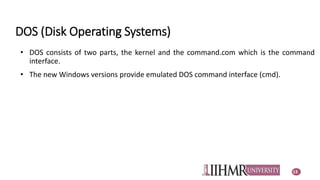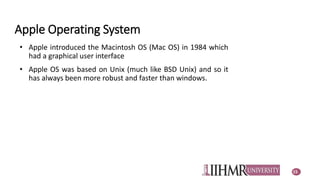Chapter 03 Operating System
- 1. Lecture 3 Operating Systems By : Narendra Singh Shekhawat 1
- 2. What will we cover What is operating Systems • Linux • Windows • Apple 2
- 3. What is an Operating System ? • An Operating System is a program that acts as an intermediary/interface between a user of a computer and the computer hardware. • OS goals: • Control/execute user/application programs. • Make the computer system convenient to use. • Ease the solving of user problems. • Use the computer hardware in an efficient manner. 3
- 4. In a simple way work of Operating Systems 4
- 5. 5
- 6. Boot Loader • Booting is a process that starts operating systems when the user turns on a computer system. • A boot sequence is the initial set of operations that the computer performs when it is switched on. • The bootloader typically loads the main operating system for the computer. 6
- 7. Functions of Operating Systems • Provide a user interface • Run programs • Manage hardware devices • Organized file storage 7
- 8. Types of Operating Systems • Single user/Single tasking OS • One user works on the system • Performs one task at a time • MS-DOS and Palm OS • Take up little space on disk • Run on inexpensive computers 8
- 9. Types of Operating Systems • Single user/Multitasking OS • User performs many tasks at once • Most common form of OS • Windows XP and OS X 9
- 10. Types of Operating Systems • Multi user/Multitasking OS • Many users connect to one computer • Each user has a unique session • UNIX, Linux, and VMS • Maintenance can be easy • Requires a powerful computer 10
- 11. UNIX Operating System • Servers generally run on Linux or other Unix-like systems • UNIX was designed as a Multi-User and Multi-Tasking OS • Various Proprietary UNIX OS like IBM AIX, SUN Solaris, SGI IRIX, HP HP-UX etc and public domain OS like various variants of LINUX are available. 11
- 12. HP – Unix OS 12
- 13. DOS (Disk Operating Systems) • DOS consists of two parts, the kernel and the command.com which is the command interface. • The new Windows versions provide emulated DOS command interface (cmd). 13
- 14. DOS 14
- 15. Apple Operating System • Apple introduced the Macintosh OS (Mac OS) in 1984 which had a graphical user interface • Apple OS was based on Unix (much like BSD Unix) and so it has always been more robust and faster than windows. 15
- 16. Windows Operating System • Microsoft first introduced an operating environment named Windows in November 1985 as an add-on to MS-DOS in response to the growing interest in graphical user interfaces (GUIs). It was a 16 Bit OS running on top of DOS providing Multitasking and GUI • Windows 3.0 (1990) and Windows Workgroup 3.11 (1992) improved the design and were 16/32 Bit OS. Windows 3.1 had Internet Explorer browser as a part of the OS. • Later came Windows 95 (1995), Windows 98 (1998) and Windows ME (2000) which were 32 Bit OS and used FAT File System and supported DOS also 16
- 17. How many OS are there in the market? • Any Guess? • https://udger.com/resources/ua-list/os 17

